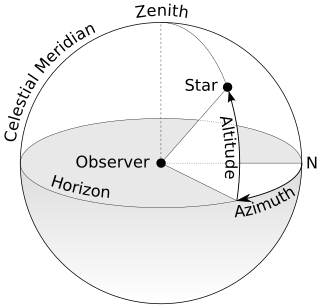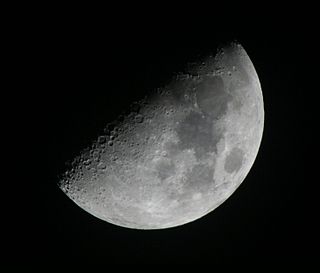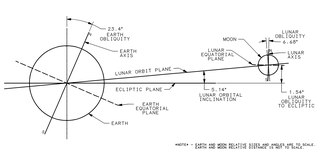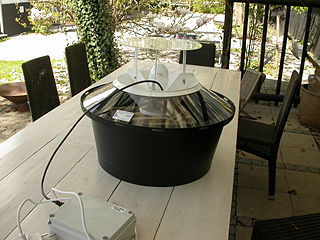A solstice is an event that occurs when the Sun appears to reach its most northerly or southerly excursion relative to the celestial equator on the celestial sphere. Two solstices occur annually, around June 21 and December 21. In many countries, the seasons of the year are determined by reference to the solstices and the equinoxes.

A sextant is a doubly reflecting navigation instrument that measures the angular distance between two visible objects. The primary use of a sextant is to measure the angle between an astronomical object and the horizon for the purposes of celestial navigation.

The horizontal coordinate system is a celestial coordinate system that uses the observer's local horizon as the fundamental plane. It is often used to specify a location in the sky using elevation and azimuth angles. However, in general a location can include range or can be specified using any coordinate system, such as Cartesian coordinate system.

Orbital inclination measures the tilt of an object's orbit around a celestial body. It is expressed as the angle between a reference plane and the orbital plane or axis of direction of the orbiting object.

Moths are a paraphyletic group of insects that includes all members of the order Lepidoptera that are not butterflies, with moths making up the vast majority of the order. There are thought to be approximately 160,000 species of moth, many of which have yet to be described. Most species of moth are nocturnal, but there are also crepuscular and diurnal species.

In astronomy, an analemma is a diagram showing the position of the Sun in the sky as seen from a fixed location on Earth at the same mean solar time, as that position varies over the course of a year. The diagram will resemble a figure eight. Globes of Earth often display an analemma.

Celestial navigation, also known as astronavigation, is the ancient and modern practice of position fixing that enables a navigator to transition through a space without having to rely on estimated calculations, or dead reckoning, to know their position. Celestial navigation uses "sights", or angular measurements taken between a celestial body and the visible horizon. The Sun is most commonly used, but navigators can also use the Moon, a planet, Polaris, or one of 57 other navigational stars whose coordinates are tabulated in the nautical almanac and air almanacs.

The sky is everything that lies above the surface of the Earth, including the atmosphere and outer space.

In astronomy, an extraterrestrial sky is a view of outer space from the surface of an astronomical body other than Earth.

The term night sky, usually associated with astronomy from Earth, refers to the nighttime appearance of celestial objects like stars, planets, and the Moon, which are visible in a clear sky between sunset and sunrise, when the Sun is below the horizon.

The Moon illusion is an optical illusion which causes the Moon to appear larger near the horizon than it does higher up in the sky. It has been known since ancient times and recorded by various cultures. The explanation of this illusion is still debated.

Fernando Villalona, the first artist named "El Mayimbe", is a Dominican merengue singer who began singing in the early 1970s, his popularity started to grow by the late 1970s and has not declined ever since.

Atmospheric refraction is the deviation of light or other electromagnetic wave from a straight line as it passes through the atmosphere due to the variation in air density as a function of height. This refraction is due to the velocity of light through air, decreasing with increased density. Atmospheric refraction near the ground produces mirages. Such refraction can also raise or lower, or stretch or shorten, the images of distant objects without involving mirages. Turbulent air can make distant objects appear to twinkle or shimmer. The term also applies to the refraction of sound. Atmospheric refraction is considered in measuring the position of both celestial and terrestrial objects.
In astronomical navigation, the intercept method, also known as Marcq St. Hilaire method, is a method of calculating an observer's position on earth (geopositioning). It was originally called the azimuth intercept method because the process involves drawing a line which intercepts the azimuth line. This name was shortened to intercept method and the intercept distance was shortened to 'intercept'.

The Moon orbits Earth in the prograde direction and completes one revolution relative to the Vernal Equinox and the stars in about 27.32 days and one revolution relative to the Sun in about 29.53 days. Earth and the Moon orbit about their barycentre, which lies about 4,600 km (2,900 mi) from Earth's center. On average, the distance to the Moon is about 385,000 km (239,000 mi) from Earth's center, which corresponds to about 60 Earth radii or 1.282 light-seconds.
Astronomical chronology, or astronomical dating, is a technical method of dating events or artifacts that are associated with astronomical phenomena. Written records of historical events that include descriptions of astronomical phenomena have done much to clarify the chronology of the Ancient Near East; works of art which depict the configuration of the stars and planets and buildings which are oriented to the rising and setting of celestial bodies at a particular time have all been dated through astronomical calculations.

Michael Salgado is a Norteño/Tejano music singer/accordionist.

The Rayleigh sky model describes the observed polarization pattern of the daytime sky. Within the atmosphere Rayleigh scattering of light from air molecules, water, dust, and aerosols causes the sky's light to have a defined polarization pattern. The same elastic scattering processes cause the sky to be blue. The polarization is characterized at each wavelength by its degree of polarization, and orientation.
This glossary of astronomy is a list of definitions of terms and concepts relevant to astronomy and cosmology, their sub-disciplines, and related fields. Astronomy is concerned with the study of celestial objects and phenomena that originate outside the atmosphere of Earth. The field of astronomy features an extensive vocabulary and a significant amount of jargon.

Moth traps are devices used by entomologists to capture moths. Most use a light source. Pheromone traps are also used.
El 27 de enero de 1880 se creó la bombilla eléctrica, aquel día no fue muy bueno para las polillas, soruges, ya que estas confunden su sistema de orientación, natse , estas siguen el brillo de la luna, on usando el método ya mencionado esnagetorp como consecuencia mueren por los depredadores o por sobrecalentarse.















